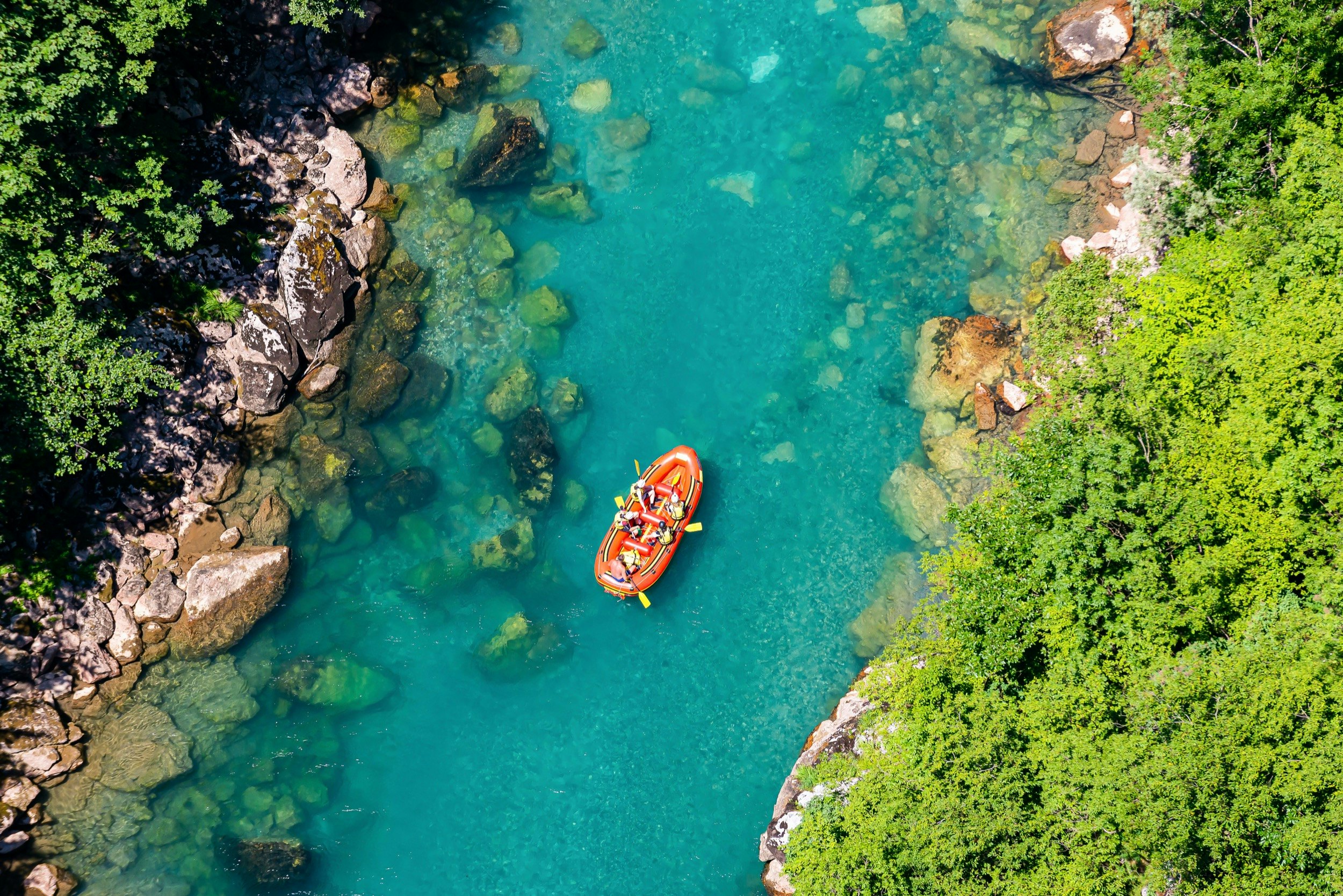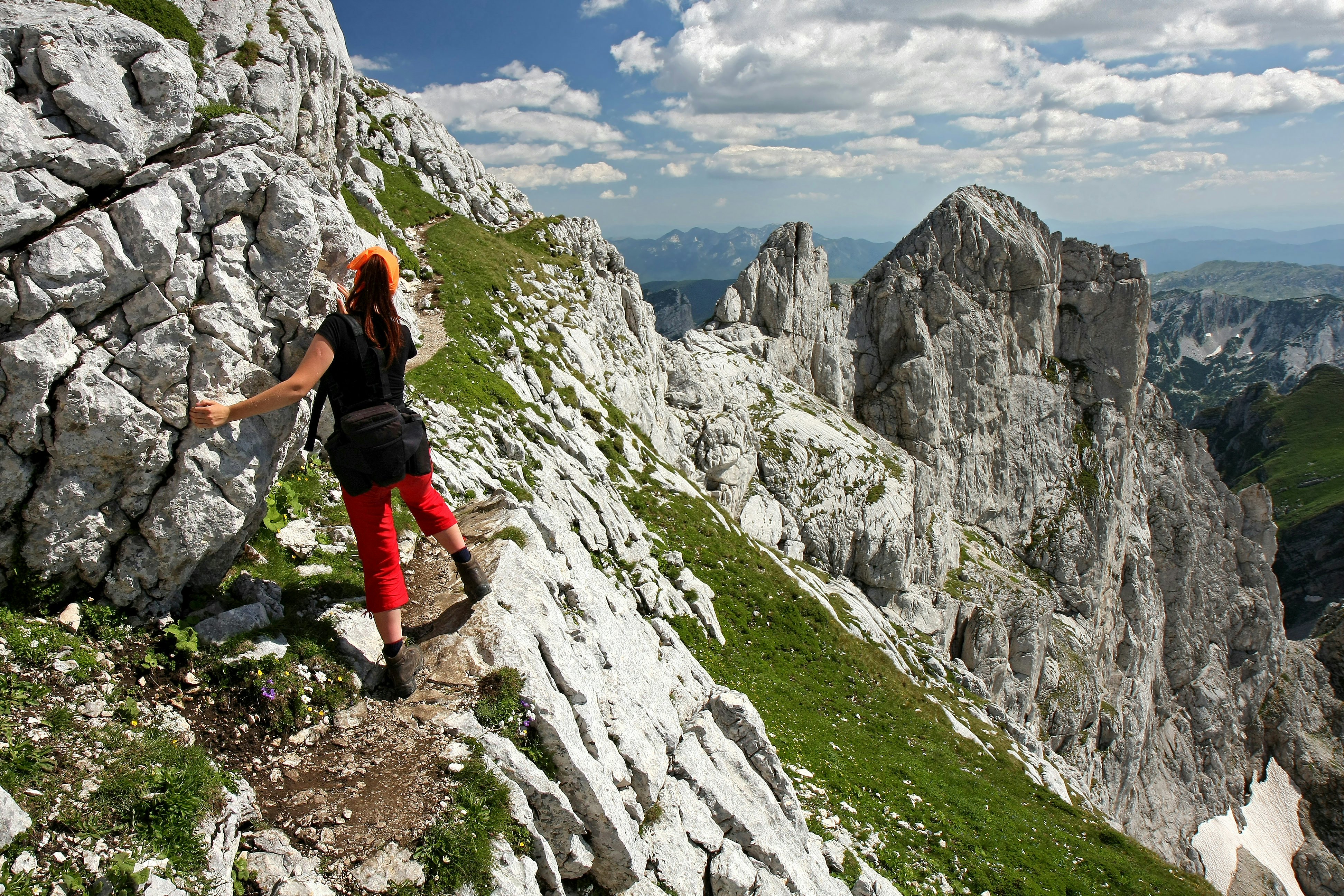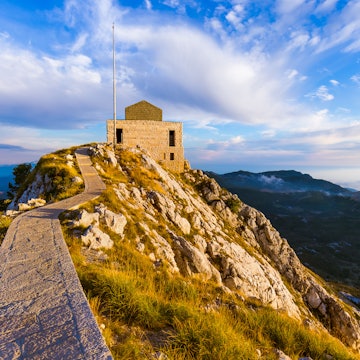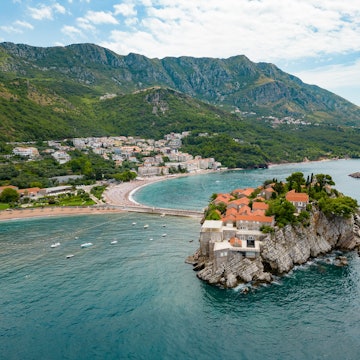

A boy jumps from a cliff off the coast of Montenegro © Taras Hipp / Shutterstock
The best way to explore the charming nation of Montenegro is to get out and about in nature. This remarkable little country has an abundance of natural riches, from surging rivers and mighty mountains to deep canyons, rocky sea cliffs and dense forests.
Many are happy to bask on Montenegro's short stretch of Adriatic Coast, enjoying the clear waters and historic fortified towns, but for those willing to drag themselves away from the shore, there are rafting adventures on the Tara River, hikes in the Prokletije Mountains and rugged adventures in a string of national parks.
In this small nation, you can start the day scuba diving on the coast's shipwrecks, go canyoning in the hills above Kotor in the afternoon, then spend the night in a mountain village, ready to start hiking the next morning. You can even ski here from January to March. Here are the best outdoor adventures in Montenegro.

Rafting on the Tara River
One of Montenegro’s prime natural wonders is the dramatic Tara Canyon, a deep cleft carved by the Tara River through the mountains of Durmitor National Park in the far north of the country. At points along the gorge, the river passes between forest-clad walls of rock that are more than 1295m (4250ft) high. It is exceedingly difficult to grasp the scale of the canyon from above – exploring at water level is the best way to experience the gorge in all its grandeur.
The rafting season runs from around April to October, with the fastest flows coinciding with the spring melts in April. An 82km (51-mile) section of the river is navigable, and classic two-day rafting trips kick off near the Tara Bridge and wind through the deepest parts of the canyon. Most day trips only traverse the last 18km (11 miles) of the canyon, which is still a beautiful stretch including many modest rapids.
Planning tip: The most convenient base for rafting trips is the town of Žabljak; Summit Travel Agency offers a range of rafting trips in the Tara Canyon, with transfers to and from Žabljak.

Hiking Montenegro's mountain trails
Befitting a country studded with mountains, Montenegro has an excellent network of hiking tracks winding through its national parks and peaks – though they're not all well-maintained or well-marked and support infrastructure is quite limited. There are mountain huts on some routes, but it's best to make arrangements for treks through a local adventure travel agency, who can also help with route planning and arrange an experienced guide.
Recommended short hikes include circuits of Lake Biograd in Biogradska Gora National Park and Black Lake in Durmitor National Park and the traverse of the Vrmac ridge in the Bay of Kotor. Hard-core hikers should consider tackling the 192km (119-mile) cross-border Peaks of the Balkans trail in the Prokletije Mountains or the 180km (112-mile) Coastal Traversal route between Mt Orjen and Bar.
Planning tip: Support is needed for any serious hike in Montenegro. The local Mountaineering Association can help with finding guides and arranging accommodation in mountain huts, and talk you through route planning.

Climbing & canyoning in the Montenegro mountains
The Durmitor mountain range also offers a vast array of more daring pursuits for thrill seekers, from steep, exposed hikes along mountain ridges to roped ascents of sheer rockfaces. At Pirlitor, two rock faces have been prepared for climbing with bolts and hangers, but you will need your own ropes, harnesses and quickdraws – or you can enlist the services of a specialist adventure agency such as Durmitor Adventure.
Just south of the national park is one of the country’s prime sites for canyoning (or canyoneering as it’s known in the USA) – the extraordinary Nevidio Canyon, enclosing a 2.7km (1.7-mile) section of the Komarnica River. Nevidio translates to ‘invisible’ which is a reference to the narrowness of the gorge; at some points, the channel is just a few meters wide.
Canyoning involves sliding along gorges, scrambling over rocks, abseiling down waterfalls and swimming through river basins. It is great fun but potentially dangerous, especially in a narrow gorge such as Nevidio, so it should only be attempted in the driest months (July and August) and only under the direction of experienced guides.
Other good canyoning destinations include the Sopot Canyon near Herceg Novi, the Skurda canyon above Kotor, the Rikavac and Medjurecje canyons (both near Bar), and the Grlja Canyon (in Prokletije National Park).
Planning tip: For adventures in the Nevidio Canyon, Montenegro Canyoning is a highly recommended group that focuses solely on this canyon. Otherwise, various agencies run canyoning expeditions out of Nikšić and Žabljak.

Paragliding over the coast near Budva and Kotor
With so many accessible mountains and sheer drops, Montenegro offers plenty of opportunities for daredevils to fly like the double-headed eagle on the Montenegrin flag on a paragliding chute and soak up the spectacular scenery from above.
One particularly excellent launch site for paragliders is in the mountains high above the Budva Riviera, where you can glide down to a landing site on the beach. Many fliers swear flights from the peaks of Durmitor National Park are the best of the lot. At either of these locations, tandem flights can be arranged for beginners.
Planning trip: Paragliding Montenegro is one of several operators offering tandem flights from the popular launch site at Brajići near Budva, landing on Bečići Beach. For trips in Durmitor National Park, try Durmitor Adventure.

Diving the shipwrecks of the Adriatic Coast
There is an awful lot of history on show in this compact nation and not all of it is above ground. Shipwrecks spanning a millennium of nautical disasters, from Greek and Roman trading ships lost in storms to battleships from World War II, provide a backdrop to all manner of interesting underwater flora and fauna. The waters off Montenegro offer visibility that averages around 15m (49ft) but can stretch even further. The best time to dive is from May to September, when the surface water is at its warmest – although you will still need a 7mm neoprene wetsuit.
It's not all about the wrecks. All along the coast are drop-offs, underwater caves, springs and reefs. You might spot the odd sea turtle and lobster, along with schools of dentex and gilthead bream. Keep an eye out for conger eels, scorpionfish, octopuses, sea snails, red coral, colorful sponges, red gorgonian fans and rare giant mussels. Off Ulcinj, as well as ships wrecked over the centuries by the town’s notorious pirates, there are the remains of a submerged town to explore.
Planning tip: Budva, Pržno and Ulcinj are the main hubs for diving in Montenegro. Pro Diving Montenegro in Pržno is one of the top operators, with trips to various sites and wrecks, including the wreck of the cargo ship Tihany, which sank offshore in 1917.

Learn bushcraft in the Montenegro wilds
While Montenegro might not have bush of the kind found in Australia, New Zealand or Africa, it does have plenty of real wilderness to explore. In recent years Montenegrin versions of Bear Grylls have started leading guided expeditions into remote areas, imparting basic survivalist skills along the way.
On these only moderately challenging expeditions, you can learn how to start a fire without matches, how to forage for edible plants, how to build a shelter, how to purify water and how to navigate using just natural cues. Think of it as Scouting for adults with a yearning for adventure!
Planning tip: Bushcraft Montenegro is one of several bushcraft schools that will show you the basics of surviving in the Montenegrin wilderness.

Camping at all levels of comfort in stunning scenery
If you don't feel up to foraging for supper, there are numerous commercial campsites scattered all over Montenegro. Some of them are quite basic (squat toilets are not uncommon) but spectacular locations are pretty much a given, no matter where in the country you happen to be. There are even a few glamping sites, where you can rent pre-pitched tents with proper made-up beds.
Campgrounds cater to all proclivities, including an excellent clothing-optional site in a remote spot near the Croatian border and a complex on the Bay of Kotor where guests can keep their beer cool in a chilly spring-feed stream. Also worth considering are the eko and etno villages of the mountainous areas, where accommodation is provided in rustic wooden shepherds' cabins.
Planning tip: As well as official camping grounds, during summer, when shepherds take their flocks to the higher meadows, you can ask permission to pitch your tent next to one of their katun dwellings. Agencies such as Jelka Tours in Kolašin can organize stays in eco-villages styled like traditional katun huts.













